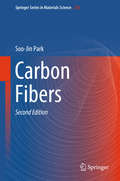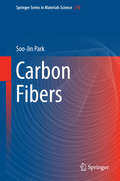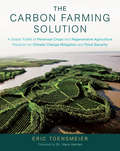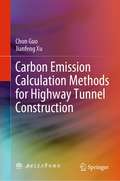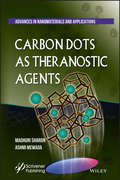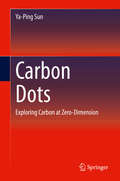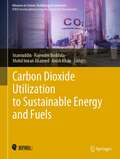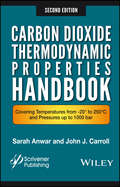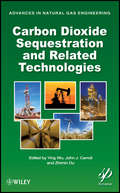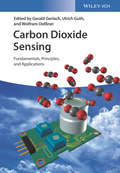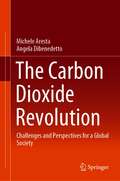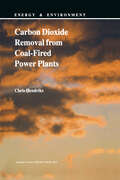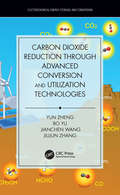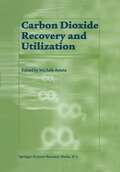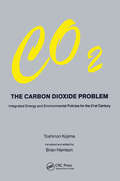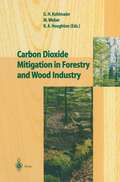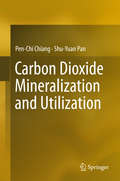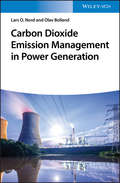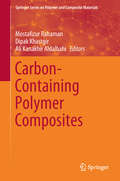- Table View
- List View
Carbon Fibers (Springer Series in Materials Science #210)
by Soo-Jin ParkThe updated and expanded second edition of this book explores the physical and mechanical properties of carbon fibers and their composites, their manufacture and processing, and their current and emerging applications. Over 10 chapters, the book describes manufacturing methods, surface treatment, composite interfaces, and microstructure-property relationships with underlying fundamental physical and mechanical principles. It discusses the application of carbon materials in delivering improved performance across a diverse range of fields including sports, wind energy, oil and gas, infrastructure, defence, and the aerospace, automotive and semiconductor industries.This new edition introduces chapters related to the manufacturing of carbon/carbon composites (C/C composites), antioxidation characteristics of C/C composites, and their applications. Furthermore, it addresses the effect of graphene and carbon nanotubes on the physical and chemical properties of carbon fibers. A final chapter looks at the emerging and future prospects for carbon fiber technology.
Carbon Fibers (Springer Series in Materials Science #210)
by Soo-Jin ParkThis book contains eight chapters that discuss the manufacturing methods, surface treatment, composite interfaces, microstructure-property relationships with underlying fundamental physical and mechanical principles, and applications of carbon fibers and their composites.Recently, carbon-based materials have received much attention for their many potential applications. The carbon fibers are very strong, stiff, and lightweight, enabling the carbon materials to deliver improved performance in several applications such as aerospace, sports, automotive, wind energy, oil and gas, infrastructure, defense, and semiconductors. However, the use of carbon fibers in cost-sensitive, high-volume industrial applications is limited because of their relatively high costs. However, its production is expected to increase because of its widespread use in high-volume industrial applications; therefore, the methods used for manufacturing carbon fibers and carbon-fiber-reinforced composites and their structures and characteristics need to be investigated.
The Carbon Farming Solution: A Global Toolkit of Perennial Crops and Regenerative Agriculture Practices for Climate Change Mitigation and Food Security
by Eric Toensmeier Dr Hans HerrenWith carbon farming, agriculture ceases to be part of the climate problem and becomes a critical part of the solution Agriculture is rightly blamed as a major culprit of our climate crisis. But in this groundbreaking new book, Eric Toensmeier argues that agriculture—specifically, the subset of practices known as “carbon farming”—can, and should be, a linchpin of a global climate solutions platform. Carbon farming is a suite of agricultural practices and crops that sequester carbon in the soil and in above-ground biomass. Combined with a massive reduction in fossil fuel emissions—and in concert with adaptation strategies to our changing environment— carbon farming has the potential to bring us back from the brink of disaster and return our atmosphere to the “magic number” of 350 parts per million of carbon dioxide. Toensmeier’s book is the first to bring together these powerful strategies in one place, including in-depth analysis of the available research and, where research is lacking, a discussion of what it will take to get us there. Carbon farming can take many forms. The simplest practices involve modifications to annual crop production. Although many of these modifications have relatively low sequestration potential, they are widely applicable and easily adopted, and thus have excellent potential to mitigate climate change if practiced on a global scale. Likewise, grazing systems such as silvopasture are easily replicable, don’t require significant changes to human diet, and—given the amount of agricultural land worldwide that is devoted to pasture—can be important strategies in the carbon farming arsenal. But by far, agroforestry practices and perennial crops present the best opportunities for sequestration. While many of these systems are challenging to establish and manage, and would require us to change our diets to new and largely unfamiliar perennial crops, they also offer huge potential that has been almost entirely ignored by climate crusaders. Many of these carbon farming practices are already implemented globally on a scale of millions of hectares. These are not minor or marginal efforts, but win-win solutions that provide food, fodder, and feedstocks while fostering community self-reliance, creating jobs, protecting biodiversity, and repairing degraded land—all while sequestering carbon, reducing emissions, and ultimately contributing to a climate that will remain amenable to human civilization. Just as importantly to a livable future, these crops and practices can contribute to broader social goals such as women’s empowerment, food sovereignty, and climate justice. The Carbon Farming Solution does not present a prescription for how cropland should be used and is not, first and foremost, a how-to manual, although following up on references in a given section will frequently provide such information. Instead, The Carbon Farming Solution is—at its root—a toolkit. It is the most complete collection of climate-friendly crops and practices currently available. With this toolkit, farmers, communities, and governments large and small, can successfully launch carbon farming projects with the most appropriate crops and practices to their climate, locale, and socioeconomic needs. Toensmeier’s ultimate goal is to place carbon farming firmly in the center of the climate solutions platform, alongside clean solar and wind energy. With The Carbon Farming Solution, Toensmeier wants to change the discussion, impact policy decisions, and steer mitigation funds to the research, projects, and people around the world who envision a future where agriculture becomes the protagonist in this fraught, urgent, and unprecedented drama of our time. Citizens, farmers, and funders will be inspired to use the tools presented in this important new book to transform degraded lands around the world into productive carbon-storing landscapes.
Carbon Emission Calculation Methods for Highway Tunnel Construction
by Chun Guo Jianfeng XuThis book introduces the research background and significance of carbon emissions in the tunnel industry and systematically reviewed the research progresses of carbon emission researches for tunnels, LCA (life cycle assessment) research framework, and uncertainty research progress. The authors propose a novel modular carbon emission calculation method for highway tunnel construction and expounds on the modular LCA system boundary theory of tunnel construction. This method does not require abundant knowledge of LCA modeling, which is convenient for general engineering and technical personnel to calculate the carbon emission level of tunnel construction. The calculation formulas for input and carbon emissions of each module are provided. It also analyzes the parameter uncertainty, model uncertainty, and scenario uncertainty of the carbon emissions from tunnel construction by the Monte Carlo method. Further, this book proposes the fitting model of carbon emissions of unit engineering quantity in tunnel construction, which benefits to simplify the calculation of carbon emissions.This book is mainly aimed at engineering and technical personnel in the construction industry, especially tunnel and underground engineering, including tunnel design engineers; tunnel construction engineers, experts, and scholars; tunnel owners; management departments.
Carbon Dots As Theranostic Agents: Syntheis, Properties And Applications In Therapeutics And Diagnostics
by Madhuri Sharon Ashmi MewadaThis book introducing all researchers and students who are interested in pursuing their research in the field of application of carbon dots in health care especially as a theranostic agent. It focuses on the fundamental understanding along with the applications of this unique fluorescent nanobiomachine, the Carbon Dot. The book begins with the explanation that carbon dots fall between the usual daily macro or bulk physics and the quantum mechanics and covers their unique properties like quantum mechanics and quantum confinement. It then encompasses the domain of various physical, chemical and biological methods that efficiently synthesizes the carbon dots and their desired properties. The basic characterization techniques used for carbon dots is also covered in this book. Conjugation of carbon dots with different moieties is another aspect that enhances its applications, hence this is highlighted too. The final attributes of this book is that how to maneuver the carbon dots for their use in targeted drug delivery with emphasis on cancer and neurodegenerative disease as well as cellular imaging and diagnostics. One of the unique features of this book is that it has looked into the use of carbon dots to act as a nanofertilizer, as a drug/antibiotic delivery vehicle to diseased plants through foliar application.
Carbon Dots: Exploring Carbon at Zero-Dimension
by Ya-Ping SunWritten by the founder of the field of carbon “quantum” dots (carbon dots) and related technology, this book outlines the principles of carbon dots and presents strong evidence for that small carbon nanoparticles and by extension carbon dots represent the nanoscale carbon allotrope at zero-dimension. Historical accounts of the inception and evolution of the carbon dots field are provided. Experimental approaches and techniques for the dot synthesis and some related major issues are discussed in detail. The photoexcited state properties, especially the bright and colorful photoluminescence emissions, and photoinduced redox characteristics of carbon dots are presented, and so are their advantages over semiconductor quantum dots as well as fullerenes. Carbon dots are also compared with “graphene quantum dots”, for which a unified mechanistic understanding is proposed. Finally, a broad range of applications of carbon dots and their derived hybrid nanostructures in biomedical, renewable energy, food and environmental safety, and other technologies are highlighted. The book concludes with a discussion on the excellent potential and opportunities for further research and development.
Carbon Dioxide Utilization to Sustainable Energy and Fuels (Advances in Science, Technology & Innovation)
by Inamuddin Rajender Boddula Mohd Imran Ahamed Anish KhanThis edited book provides an in-depth overview of carbon dioxide (CO2) transformations to sustainable power technologies. It also discusses the wide scope of issues in engineering avenues, key designs, device fabrication, characterizations, various types of conversions and related topics. It includes studies focusing on the applications in catalysis, energy conversion and conversion technologies, etc. This is a unique reference guide, and one of the detailed works is on this technology. The book is the result of commitments by leading researchers from various backgrounds and expertise. The book is well structured and is an essential resource for scientists, undergraduate, postgraduate students, faculty, R&D professionals, energy chemists and industrial experts.
Carbon Dioxide Thermodynamic Properties Handbook: Covering Temperatures from -20° to 250°C and Pressures up to 1000 Bar
by Sara Anwar John J. CarrollWith new graphical data added to this revision of the original classic, this volume is still the largest and most comprehensive collection of thermodynamic data on carbon dioxide ever produced, the ONLY book of its kind in print. With carbon dioxide sequestration gaining in popularity around the world in the scientific and engineering communities, having this data in an easy-to-access format is more useful and timely than ever. With data that is accurate down to within a fraction of a degree, this handbook offers, in one volume, literally thousands of data points that any engineer or chemist would need when dealing with carbon dioxide. Not available in other formats, these easy-to-read tables are at your fingertips and are accessed within seconds and does away with the need for constantly working with mathematical formulas. Carbon dioxide is used in many fields, across many industries, including the oil and gas industry and food processing. Even coffee is decaffeinated using carbon dioxide! Though CO2 has many uses in industry, it is also one of the most offensive of the greenhouse gases, on which many scientists and engineers are working to eradicate in the future production of power and fuel. This data is useful for any scientist or engineer in any of these fields, but it is also useful for the chemical engineering or petroleum engineering student.
Carbon Dioxide Thermodynamic Properties Handbook: Covering Temperatures from -20° to 250°C and Pressures up to 1000 Bar
by Sara Anwar John J. CarrollWith new graphical data added to this revision of the original classic, this volume is still the largest and most comprehensive collection of thermodynamic data on carbon dioxide ever produced, the ONLY book of its kind in print. With carbon dioxide sequestration gaining in popularity around the world in the scientific and engineering communities, having this data in an easy-to-access format is more useful and timely than ever. With data that is accurate down to within a fraction of a degree, this handbook offers, in one volume, literally thousands of data points that any engineer or chemist would need when dealing with carbon dioxide. Not available in other formats, these easy-to-read tables are at your fingertips and are accessed within seconds and does away with the need for constantly working with mathematical formulas. Carbon dioxide is used in many fields, across many industries, including the oil and gas industry and food processing. Even coffee is decaffeinated using carbon dioxide! Though CO2 has many uses in industry, it is also one of the most offensive of the greenhouse gases, on which many scientists and engineers are working to eradicate in the future production of power and fuel. This data is useful for any scientist or engineer in any of these fields, but it is also useful for the chemical engineering or petroleum engineering student.
Carbon Dioxide Sequestration and Related Technologies (Advances in Natural Gas Engineering)
by John J. Carroll Ying Wu Zhimin DuCarbon dioxide sequestration is a technology that is being explored to curb the anthropogenic emission of CO2 into the atmosphere. Carbon dioxide has been implicated in the global climate change and reducing them is a potential solution. The injection of carbon dioxide for enhanced oil recovery (EOR) has the duel benefit of sequestering the CO2 and extending the life of some older fields. Sequestering CO2 and EOR have many shared elements that make them comparable. This volume presents some of the latest information on these processes covering physical properties, operations, design, reservoir engineering, and geochemistry for AGI and the related technologies.
Carbon Dioxide Sequestration and Related Technologies (Advances in Natural Gas Engineering)
by Ying Alice Wu John J. Carroll Zhimin DuCarbon dioxide sequestration is a technology that is being explored to curb the anthropogenic emission of CO2 into the atmosphere. Carbon dioxide has been implicated in the global climate change and reducing them is a potential solution. The injection of carbon dioxide for enhanced oil recovery (EOR) has the duel benefit of sequestering the CO2 and extending the life of some older fields. Sequestering CO2 and EOR have many shared elements that make them comparable. This volume presents some of the latest information on these processes covering physical properties, operations, design, reservoir engineering, and geochemistry for AGI and the related technologies.
Carbon Dioxide Sensing: Fundamentals, Principles, and Applications
by Gerald GerlachThe book provides the reader with a profound knowledge of basic principles, properties and preferred applications of diverse kinds of CO2 measurement. It shows the advantages, disadvantages and limitations of several methods and gives a comprehensive overview of both possible applications and corresponding boundary conditions. Applications reach from environmental monitoring to safety control to biotechnology and food control and finally to medicine.
Carbon Dioxide Sensing: Fundamentals, Principles, and Applications
by Gerald Gerlach Ulrich Guth Wolfram OelßnerThe book provides the reader with a profound knowledge of basic principles, properties and preferred applications of diverse kinds of CO2 measurement. It shows the advantages, disadvantages and limitations of several methods and gives a comprehensive overview of both possible applications and corresponding boundary conditions. Applications reach from environmental monitoring to safety control to biotechnology and food control and finally to medicine.
The Carbon Dioxide Revolution: Challenges and Perspectives for a Global Society
by Michele Aresta Angela DibenedettoThis book focuses on carbon dioxide and its global role in our everyday life. Starting with society's dependency on energy, it demonstrates the various sources of carbon dioxide and discusses the putative effects of its accumulation in the atmosphere and its impact on the climate. It then provides an overview of how we can reduce carbon dioxide production and reviews innovative technologies and alternative energy resources. The book closes with a perspective on how carbon dioxide can be utilized reasonably and how mimicking nature can provide us with a solution. Using simple language, this book discusses one of today's biggest challenges for the future of our planet in a way that is understandable for the general public. The authors also provide deep insights into specific issues, making the book a useful resource for researchers and students.
Carbon Dioxide Removal from Coal-Fired Power Plants (Energy & Environment #1)
by C. Hendriks1. 1. Greenhouse gas emissions and climate change . . . . . . . . . . . . . . 3 1. 1. 1. Emissions and concentrations of greenhouse gases 3 1. 1. 2. Impact of increasing greenhouse gases concentration 4 1. 2. Options to reduce carbon dioxide emissions 5 1. 2. 1. Carbon dioxide removal 8 1. 3. Scope of the thesis 10 1. 4. Outline of the thesis. . . . . . . . . . . . . . . . . . . . . . . . . . . . . . . . . 11 1. 4. 1. General evaluation method. . . . . . . . . . . . . . . . . . . . . . . 12 1. 4. 2. Some notes . . . . . . . . . . . . . . . . . . . . . . . . . . . . . . . . . . . 13 II. Simulation and optimization of carbon dioxide recovery from the flue gases of a coal-fired power plant using amines 14 Abstract 19 2. 1. Introduction . . . . . . . . . . . . . . . . . . . . . . . . . . . . . . . . . . . . . . . 20 2. 2. The chemical absorption process. . . . . . . . . . . . . . . . . . . . . . . . 22 2. 2. 1. General process description. . . . . . . . . . . . . . . . . . . . . . . 22 2. 2. 2. Types of absorbent 23 2. 2. 3. Effects of flue gas contaminants 24 2. 3. Simulation of the scrubber in ASPEN PLUS . . . . . . . . . . . . . . . . . 25 2. 3. 1. ASPEN PLUS for flow sheet simulation 26 2. 3. 2. Simulation of the performance for the base-case design . . 26 the scrubber . . . . . . . . . . . . . . . . . . . . . . 29 2. 3. 3. Optimization of 2. 3. 4. Design and results 32 2. 3. 5. Discussion. . . . . . . . . . . . . . . . . . . . . . . . . . . . . . . . . . . . 34 2. 4. Integration of the scrubber in the power plant 35 2. 4. 1. Power loss caused by steam extraction 36 2. 4. 2. Power saved by avoiding preheating boiler feed water . . . 38 2. 4. 3. Power consumption by the carbon dioxide scrubber . . . . . 38 2. 4. 4. Power consumption for carbon dioxide compression . . . . . 38 2. 4. 5. Calculation of plant efficiency losses " . . . . . . . . . . . . . . 39 2. 5.
Carbon Dioxide Reduction through Advanced Conversion and Utilization Technologies (Electrochemical Energy Storage and Conversion)
by Bo Yu Jiujun Zhang Yun Zheng Jianchen WangCarbon Dioxide Reduction through Advanced Conversion and Utilization Technologies covers fundamentals, advanced conversion technologies, economic feasibility analysis, and future research directions in the field of CO2 conversion and utilization. This book emphasizes principles of various conversion technologies for CO2 reduction such as enzymatic conversion, mineralization, thermochemical, photochemical, and electrochemical processes. It addresses materials, components, assembly and manufacturing, degradation mechanisms, challenges, and development strategies. Applications of conversion technologies for CO2 reduction to produce useful fuels and chemicals in energy and industrial systems are discussed as solutions to reduce greenhouse effects and energy shortages. Particularly, the advanced materials and technology of high temperature co-electrolysis of H2O and CO2 to produce sustainable fuels using solid oxide cells (SOCs) are reviewed and the introduction, fundamentals, and some significant topics regarding this CO2 conversion process are discussed. This book provides a comprehensive and clear picture of advanced technologies in CO2 conversion and utilization. Written in a clear and detailed manner, it is suitable for students as well as industry professionals, researchers, and academics.
Carbon Dioxide Reduction through Advanced Conversion and Utilization Technologies (Electrochemical Energy Storage and Conversion)
by Bo Yu Jiujun Zhang Yun Zheng Jianchen WangCarbon Dioxide Reduction through Advanced Conversion and Utilization Technologies covers fundamentals, advanced conversion technologies, economic feasibility analysis, and future research directions in the field of CO2 conversion and utilization. This book emphasizes principles of various conversion technologies for CO2 reduction such as enzymatic conversion, mineralization, thermochemical, photochemical, and electrochemical processes. It addresses materials, components, assembly and manufacturing, degradation mechanisms, challenges, and development strategies. Applications of conversion technologies for CO2 reduction to produce useful fuels and chemicals in energy and industrial systems are discussed as solutions to reduce greenhouse effects and energy shortages. Particularly, the advanced materials and technology of high temperature co-electrolysis of H2O and CO2 to produce sustainable fuels using solid oxide cells (SOCs) are reviewed and the introduction, fundamentals, and some significant topics regarding this CO2 conversion process are discussed. This book provides a comprehensive and clear picture of advanced technologies in CO2 conversion and utilization. Written in a clear and detailed manner, it is suitable for students as well as industry professionals, researchers, and academics.
Carbon Dioxide Recovery and Utilization
by Michele ArestaCarbon Dioxide Recovery and Utilization is a complete and informative resource on the carbon dioxide sources and market at the European Union level, with reference to the world situation. The book covers the following themes: - Sources of carbon dioxide and their purity, - Market of carbon dioxide and its uses, - Separation techniques of carbon dioxide from flue gases, - Analysis of the potential of each technique and application, - Basic science and technology of supercritical CO2, - Reactions in supercritical CO2 and its use as reactive solvent, - Utilization of CO2 in the synthesis of chemicals with low energy input, - Conversion of CO2 into fuels: existing techniques, - Dry reforming of methane, - Assessment of the use of carbon dioxide for the synthesis of methanol. This book is unique in providing integrated information and a perspective on innovative technologies for the use of carbon dioxide. The book is suitable for use as a textbook for courses in chemical engineering and chemistry. It is also of great interest as a general reference for those involved with technologies for avoiding carbon dioxide production and for economists. This is an invaluable reference for specialists on synthetic chemistry, gas separation, supercritical fluids, carbon dioxide marketing, renewable energy and sustainable development. In addition, it will be useful for those working in the chemical industry and for policy makers for carbon dioxide mitigation, innovative technologies, carbon recycling, and power generation.
Carbon Dioxide Problem: Integrated Energy and Environmental Policies for the 21st Century
by Toshinori KojimaThe problems of global warming and environmental pollution are some of the most difficult challenges this planet faces in the 21st century. Carbon dioxide, often identified as one of the culprits, is an inevitable product of the combustion of fossil fuels, necessary for our modern economies to survive. Thus, The Carbon Dioxide Problem refers to the extremely complex matter of limiting carbon dioxide concentrations to levels that pose little environmental risk without devastating national economies and reducing living standards on the planet. This timely book offers solutions to the global warming problem that lie in the development of comprehensive energy and environmental policies that emphasize the need to use energy efficiently while looking to develop alternative renewable sources. The experience of Japan is particularly relevant due to that country's great dependence on foreign fuel supplies, which has led it to be at the forefront of developing new energy conservation and antipollution technologies.
Carbon Dioxide Problem: Integrated Energy and Environmental Policies for the 21st Century
by Toshinori KojimaThe problems of global warming and environmental pollution are some of the most difficult challenges this planet faces in the 21st century. Carbon dioxide, often identified as one of the culprits, is an inevitable product of the combustion of fossil fuels, necessary for our modern economies to survive. Thus, The Carbon Dioxide Problem refers to the extremely complex matter of limiting carbon dioxide concentrations to levels that pose little environmental risk without devastating national economies and reducing living standards on the planet. This timely book offers solutions to the global warming problem that lie in the development of comprehensive energy and environmental policies that emphasize the need to use energy efficiently while looking to develop alternative renewable sources. The experience of Japan is particularly relevant due to that country's great dependence on foreign fuel supplies, which has led it to be at the forefront of developing new energy conservation and antipollution technologies.
Carbon Dioxide Mitigation in Forestry and Wood Industry
by Gundolf H. Kohlmaier Michael Weber Richard A. HoughtonThe lntergovernmental Panel on Climate Change (IPCC) has recently summarized the state ofthe art in research on climate change (Climate Change 1995). The most up to date research findings have been divided into three volumes: • the Science ofClimate Change (working group I), • the Impacts, Adaption and Mitigation of Climate Change (working group II), and • the Economic and Social Dimensions ofClimate Change (working group III) There is a general consensus that a serious change in climate can only be avoided if the future emissions of greenhouse gases are reduced considerably from the business as usual projection and if at the same time the natural sinks for greenhouse gases, in particular that of CO , are maintained at the present level or 2 preferrably increased. Forests, forestry and forestry industry are important parts of the global carbon cycle and therefore they are also part of the mitigation potentials in at least a threefold way: 1. During the time period between 1980 and 1989 there was a net emission of CO from changes in tropical land use (mostly tropical deforestation) of 2 1. 6 +/- 1 GtC/a, but at the same time it was estimated that the forests in the northem hemisphere have taken up 0. 5 +/- 0. 5 GtC/a and additionally other terrestrial sinks (including tropical forests where no clearing took place) have been a carbon sink ofthe order of l. 3 +/- l.
Carbon Dioxide Mineralization and Utilization
by Pen-Chi Chiang Shu-Yuan PanThis book focuses on an important technology for mineralizing and utilizing CO2 instead of releasing it into the atmosphere. CO2 mineralization and utilization demonstrated in the waste-to-resource supply chain can “reduce carbon dependency, promote resource and energy efficiency, and lessen environmental quality degradation,” thereby reducing environmental risks and increasing economic benefits towards Sustainable Development Goals (SDG). In this book, comprehensive information on CO2 mineralization and utilization via accelerated carbonation technology from theoretical and practical considerations was presented in 20 Chapters. It first introduces the concept of the carbon cycle from the thermodynamic point of view and then discusses principles and applications regarding environmental impact assessment of carbon capture, storage and utilization technologies. After that, it describes the theoretical and practical considerations for “Accelerated Carbonation (Mineralization)” including analytical methods, and systematically presents the carbonation mechanism and modeling (process chemistry, reaction kinetics and mass transfer) and system analysis (design and analysis of experiments, life cycle assessment and cost benefit analysis). It then provides physico-chemical properties of different types of feedstock for CO2 mineralization and then explores the valorization of carbonated products as green materials. Lastly, an integral approach for waste treatment and resource recovery is introduced, and the carbonation system is critically assessed and optimized based on engineering, environmental, and economic (3E) analysis. The book is a valuable resource for readers who take scientific and practical interests in the current and future Accelerated Carbonation Technology for CO2 Mineralization and Utilization.
Carbon Dioxide Emission Management in Power Generation
by Prof. Lars O. Nord Prof. Olav BollandProvides an engaging and clearly structured source of information on the capture and storage of CO2 Designed to bridge the gap between the many disciplines involved in carbon dioxide emission management, this book provides a comprehensive yet easy-to-understand introduction to the subject of CO2 capture. Fit for graduate students, practicing process engineers, and others interested in the subject, it offers a clear understanding and overview of thermal power plants in particular and of carbon dioxide capture and storage (CCS) in general. Carbon Dioxide Emission Management in Power Generation starts with a discussion of the greenhouse effect, climate change, and CO2 emissions as the rationale for the concept of CCS. It then looks at the long-term storage of CO2. A chapter covering different fossil fuels, their usage, and properties comes next, followed by sections on: CO2 generation, usage and properties; power plant technologies; theory of gas separation; power plant efficiency calculations; and classification of CO2 capture methods. Other chapters examine: CO2 capture by gas absorption and other gas separation methods; removing carbon from the fuel; pre- and post-combustion CO2 capture in power cycles; and oxy-combustion CO2 capture in power cycles. -Discusses both CO2 capture technologies as well as power generation technologies -Bridges the gap between many different disciplines?from scientists, geologists and engineers, to economists -One of the few books that covers all the different sciences involved in the capture and storage of CO2 -Introduces the topic and provides useful information to the academic as well as professional reader Carbon Dioxide Emission Management in Power Generation is an excellent book for students who are interested in CO2 capture and storage, as well as for chemists in industry, environmental chemists, chemical engineers, geochemists, and geologists.
Carbon Dioxide Emission Management in Power Generation
by Prof. Lars O. Nord Prof. Olav BollandProvides an engaging and clearly structured source of information on the capture and storage of CO2 Designed to bridge the gap between the many disciplines involved in carbon dioxide emission management, this book provides a comprehensive yet easy-to-understand introduction to the subject of CO2 capture. Fit for graduate students, practicing process engineers, and others interested in the subject, it offers a clear understanding and overview of thermal power plants in particular and of carbon dioxide capture and storage (CCS) in general. Carbon Dioxide Emission Management in Power Generation starts with a discussion of the greenhouse effect, climate change, and CO2 emissions as the rationale for the concept of CCS. It then looks at the long-term storage of CO2. A chapter covering different fossil fuels, their usage, and properties comes next, followed by sections on: CO2 generation, usage and properties; power plant technologies; theory of gas separation; power plant efficiency calculations; and classification of CO2 capture methods. Other chapters examine: CO2 capture by gas absorption and other gas separation methods; removing carbon from the fuel; pre- and post-combustion CO2 capture in power cycles; and oxy-combustion CO2 capture in power cycles. -Discusses both CO2 capture technologies as well as power generation technologies -Bridges the gap between many different disciplines?from scientists, geologists and engineers, to economists -One of the few books that covers all the different sciences involved in the capture and storage of CO2 -Introduces the topic and provides useful information to the academic as well as professional reader Carbon Dioxide Emission Management in Power Generation is an excellent book for students who are interested in CO2 capture and storage, as well as for chemists in industry, environmental chemists, chemical engineers, geochemists, and geologists.
Carbon-Containing Polymer Composites (Springer Series on Polymer and Composite Materials)
by Mostafizur Rahaman Dipak Khastgir Ali Kanakhir AldalbahiThis book discusses the methods synthesizing various carbon materials, like graphite, carbon blacks, carbon fibers, carbon nanotubes, and graphene. It also details different functionalization and modification processes used to improve the properties of these materials and composites. From a geometrical–structural point of view, it examines different properties of the composites, such as mechanical, electrical, dielectric, thermal, rheological, morphological, spectroscopic, electronic, optical, and toxic, and describes the effects of carbon types and their geometrical structure on the properties and applications of composites.
